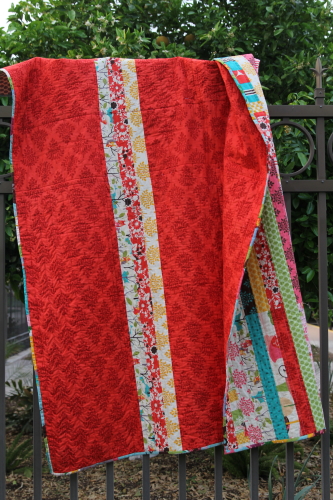a few weeks ago i got a copy of jen kingwell's new book, quilt lovely, and instantly fell in love with 99% of the patterns. in love, as in "i absolutely must stop all other plans and spend all my quilty time for the next few years making these designs." they really are spectacular. as you may know, i've had my qualms with ms. kingwell's pattern writing for gypsy wife so i was a bit leery of a whole book of her patterns, but the absolute gorgeousness of the designs makes up for any weaknesses in pattern clarity. i am in need of several new quilts for our new mountain cabin and i think these will be absolutely perfect for the place.
 |
| doesn't this one say "cabin" to you? |
the pieces for this block are so tiny! 1" high each. most quilters will throw something that small away. it reaffirmed to me that i'm not completely crazy for holding onto such small scraps, something i have a propensity to do. i started out by cutting pieces to the sizes needed and lining them up in rows according to size. there is a pile of color and a pile of neutral for each length.
 |
| first block - not very heart-ish |
putting together that first block taught me a few things about fabric choices, as well as how to put the blocks together. kate said she was surprised i could talk and work on such an intricate block at the same time. well, really, i couldn't. not very well.
i made not one but three of the smaller component blocks incorrectly! almost enough for a whole heart. ugh! oh well. they're not wasted, i'll work them into something somewhere. and they are pretty cute all on their own. i might just make one more and put them all together into one jumbled courthouse steps/log cabin block.
anyway, after getting my first block finished, i had learned a few things and wanted to test my ideas out, so i made another block. also, i didn't feel like it looked much like a heart at all. i hoped that by making more than one, side by side they would start looking heart-ish.
it does help to have more than one to give the effect of a heart. i'm thinking about making a row of them for a quilt, maybe a whole quilt out of the intricate blocks from the pillow patterns in the book. those patterns were written as pillows so you wouldn't have to commit to making a whole quilt out of them. they would be amazing that way but the work involved would be quite extensive. anyway, maybe a row of each kind would make a nice quilt altogether.
so here's what i found while working on these blocks:
1. absolute neutrals or nearly-neutrals were best for the white space parts of the block, the not-heart parts. originally i thought just low-volume was going to be good enough but i could tell immediately that i didn't want any low-volumes with color in them and weeded them out. but even low-volume prints that had an obvious pattern, like the floral or comma print i used (see above) were a little too loud, competed with the eye against seeing the heart shape formed by the colored strips. i had very few nearly-neutral low-volumes as it was so i had to invest in a few more tone-on-tone prints and solid colored neutrals for future blocks. upon closer inspection, the ones used in the book mostly seemed to be various colors of white, cream, ecru, etc. i like the effect of having different colors but the low-volume prints i used were a bit too attention getting.
 |
| good options |
 |
| not-so-good options |
here's a case of where i had a colored print with white in it and when all the seam allowances were hidden, i ended up with mostly white showing! i didn't expect that tiny tip of the heart to come out looking like this. it would have been better if i had used a solid or tone-on-tone print here. that white half of the top pink strip, coupled with the yellow part of the next strip distorts the shape of the heart because they basically disappear.
in the book, ms. kingwell suggests considering the backside of fabrics as well as the front, for their effect. this worked nicely with some of the neutrals i was using. you can see above, that if you turn them around so the wrong side is showing, you get an even subtler effect of the print.
so now i have two nice little hearts hanging out on my design wall while i get back to work on my other projects. i do find that stepping back from them and viewing them from a distance really helps them look heart-ish. and some day when i have a whole row of them, they will probably look pretty lovely and heart-like together.
 |
| daisy do - the cover quilt - which i will eventually need to make. by hand. |
 |
| spinning around - composed of three different pinwheel blocks - is the other top contender for my favorite |
this book has been read and browsed nearly every day since it got here. even if i only ever just looked at it, it was a worthwhile purchase for all the viewing pleasure it gives!
if you've seen the book, which pattern is your favorite?
linking up with lee's wip wednesday at freshly pieced































